|
|
| Mouse-over to browse the image with the 4-color sequels version attached. |
September 24 2012 witnessed an announcement of a new discovery of a comet designated C/2012 S1 (ISON) by Vitali Nevski, Vitebsk, Belarus, and Artyom Novichonok, Kondopoga, Russia on their CCD images taken on 2012 Sept 21.06 UT through a 0.4-m f/3 reflector of the International Scientific Optical Network (ISON) in the vicinity of Kislovodsk in Russia. With prediscovery data from Mt. Lemmon Survey taken on 2011 Dec 28.4 UT, MPEC 2012-S63 rendered us a parabolic orbit for the comet with prehelion distance q = 0.012 AU on T = 2013 Nov 28.9 TT. Based upon the current tendency and cometary activity of the comet, and given that the assumption of the slope K = 10.0 is made, the lightcurve predicts a peak magnitude of around -13 during the perihelion observed from the ground-based, even outshining the full moon! From the day on, I will keep an eye on the revolution of comet.
2012/09/26 2012/09/27 2012/10/15 2012/10/17 2012/12/17 2013/02/02 2013/05/09
2013/05/15 2013/08/31 2013/09/01 2013/09/11 2013/09/26 2013/10/02 2013/10/05
2013/10/08 2013/10/26 2013/11/01 2013/11/06 2013/11/12 2013/11/13 2013/11/14 2013/11/16
|
|
| Mouse-over to browse the image with the 4-color sequels version attached. |
News came several days ago that this comet was reported to be much brighter than expected, therefore, we decided to spend some time observing this comet. We could confirm that the comet is very bright. MPC observation computed with Astrometrica using both UCAC-3 and CMC-14 star catalogs -- the former for astrometric reduction and the latter for photometric work:
- COD C42
OBS M.-T. Hui, X. Gao
MEA M.-T. Hui
TEL 0.36-m f/6.9 Schmidt-Cassegrain + CCD
NET UCAC-3
CK12S010 KC2012 09 26.87314 08 14 52.74 +27 48 40.4 17.8 N C42
CK12S010 KC2012 09 26.88392 08 14 52.97 +27 48 40.2 17.8 N C42
CK12S010 KC2012 09 26.89470 08 14 53.12 +27 48 39.9 C42
----- end -----
Photometry result computed with FOCAS II, which processes images based upon the .LOG file of Astrometrica, by means of Multibox method:
Fisrt line:
OBJECT, DATE, TIME: refering to their original meanings respectively
10x10, 20x20 ... 60x60: the aperture sizes of photometry in term of rectangle in arcsec that are used to measure an object's magnitude
SNR: the Signal-to-Noise Ratio for aperture photometry
SB: stars of faintest magnitude on the images used in data reduction with the used star catalog in Astrometrica, rather than the stars of faintest magnitude in the images
COD: MPC Code of the observatory
Second line:
+/-: precisions of measurement
N: the number of used images for measurement
FWHM: Full-Width-Half-Maximum of total PSF, relevant to degree of seeing
CAT: the used star catalog in Astrometrica
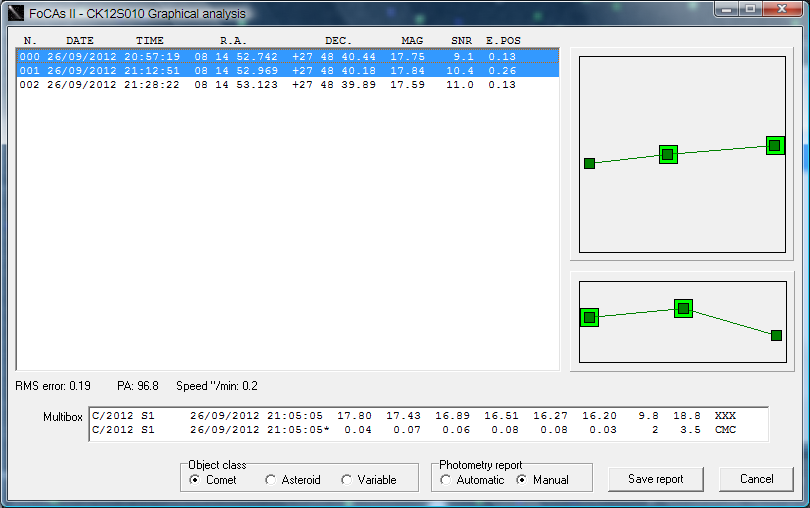
Results enclosed by larger boxes starting from 30" x 30" are useless because of contamination from the nearby star.
Copyright @ Man-To Hui 2012/09/27
|
|
| Mouse-over to browse the image with labeled versions attached. |
MPC observation computed with Astrometrica using both UCAC-3 and CMC-14 star catalogs -- the former for astrometric reduction and the latter for photometric work:
Photometry result computed with FOCAS II, which processes images based upon the .LOG file of Astrometrica, by means of Multibox method:
Fisrt line:
OBJECT, DATE, TIME: refering to their original meanings respectively
10x10, 20x20 ... 60x60: the aperture sizes of photometry in term of rectangle in arcsec that are used to measure an object's magnitude
SNR: the Signal-to-Noise Ratio for aperture photometry
SB: stars of faintest magnitude on the images used in data reduction with the used star catalog in Astrometrica, rather than the stars of faintest magnitude in the images
COD: MPC Code of the observatory
Second line:
+/-: precisions of measurement
N: the number of used images for measurement
FWHM: Full-Width-Half-Maximum of total PSF, relevant to degree of seeing
CAT: the used star catalog in Astrometrica

Copyright @ Man-To Hui 2012/10/02
|
|
| Mouse-over to browse the image with labeled versions attached. |
MPC observation computed with Astrometrica using both UCAC-3 and CMC-14 star catalogs -- the former for astrometric reduction and the latter for photometric work. The comet moves closer to a nearby star in the last three rows of time, therefore no photometry presented:
Photometry result computed with FOCAS II, which processes images based upon the .LOG file of Astrometrica, by means of Multibox method:
Fisrt line:
OBJECT, DATE, TIME: refering to their original meanings respectively
10x10, 20x20 ... 60x60: the aperture sizes of photometry in term of rectangle in arcsec that are used to measure an object's magnitude
SNR: the Signal-to-Noise Ratio for aperture photometry
SB: stars of faintest magnitude on the images used in data reduction with the used star catalog in Astrometrica, rather than the stars of faintest magnitude in the images
COD: MPC Code of the observatory
Second line:
+/-: precisions of measurement
N: the number of used images for measurement
FWHM: Full-Width-Half-Maximum of total PSF, relevant to degree of seeing
CAT: the used star catalog in Astrometrica
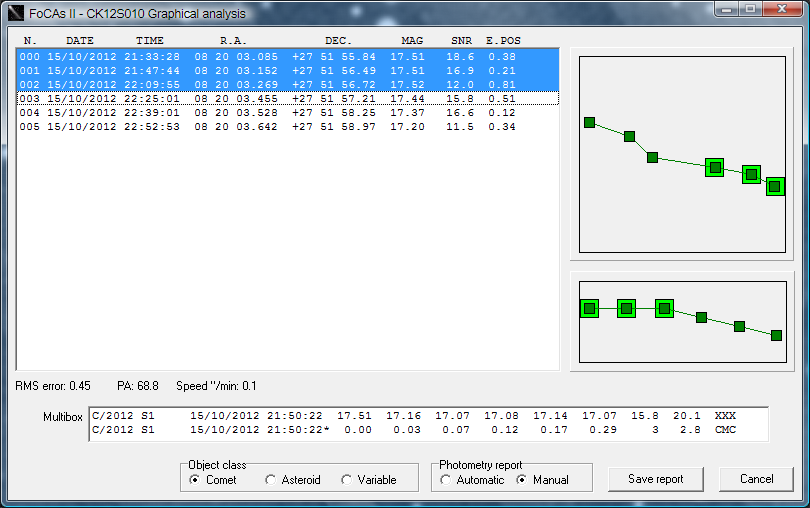
I employed software Wafrho for computation of Afρ of the comet. Only the first two rows of the 8-frame-stacked images were used as thence the comet was situated relatively far away from a star in adjacency, whereby contamination from the star could be minimized by selecting appropriate box sizes. Despite that our equipment is unfiltered, owing to the distance of the comet, wherefore the main cometary activity is dorminated by dust, what I obtained perfectly matches outcomes yielded by other observers or observatories. The comparison stars were taken from Tycho Star Catalog. Peak Afρ = 543 +/- 9 cm at a nucleocentric radius 24937 km at 21:33 UT, Oct 15 2012. For the plot I obsoleted the outcomes from the second stacked image as the largest size of the box could not be used because of intruding contamination from the nearby star. Nevertheless, the peak Afρ was found within the tolerance of the aforemention value, 540 +/- 7 cm, also at the same nucleocentric radius.
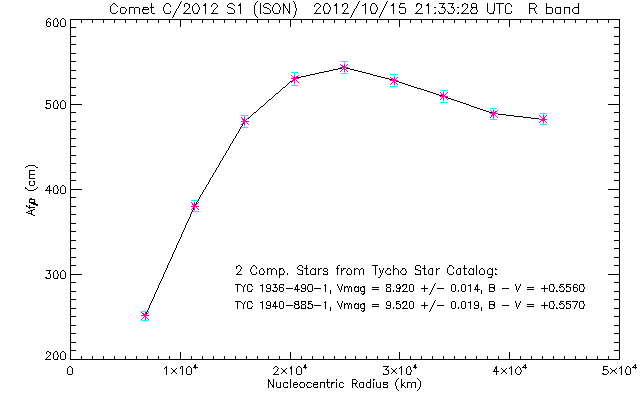
Copyright @ Man-To Hui 2012/10/17
|
|
| Mouse-over to browse the image with labeled versions attached. |
MPC observation computed with Astrometrica using both UCAC-3 and CMC-14 star catalogs -- the former for astrometric reduction and the latter for photometric work:
Photometry result computed with FOCAS II, which processes images based upon the .LOG file of Astrometrica, by means of Multibox method:
Fisrt line:
OBJECT, DATE, TIME: refering to their original meanings respectively
10x10, 20x20 ... 60x60: the aperture sizes of photometry in term of rectangle in arcsec that are used to measure an object's magnitude
SNR: the Signal-to-Noise Ratio for aperture photometry
SB: stars of faintest magnitude on the images used in data reduction with the used star catalog in Astrometrica, rather than the stars of faintest magnitude in the images
COD: MPC Code of the observatory
Second line:
+/-: precisions of measurement
N: the number of used images for measurement
FWHM: Full-Width-Half-Maximum of total PSF, relevant to degree of seeing
CAT: the used star catalog in Astrometrica
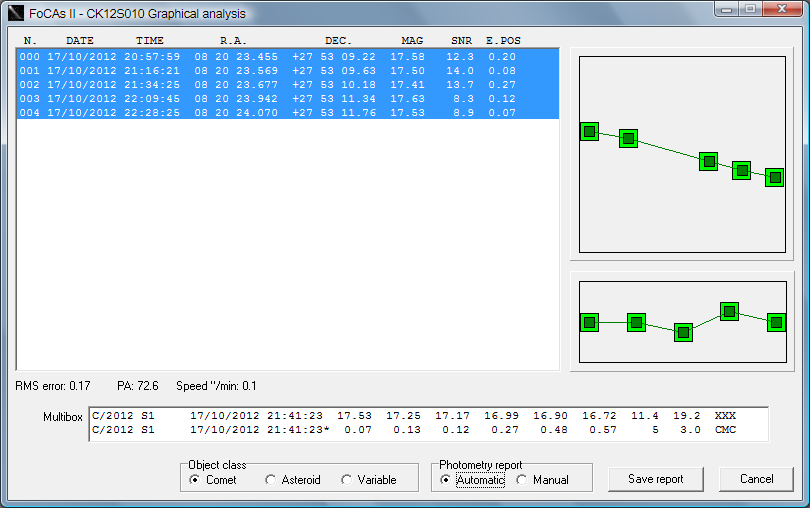
I computed Afρ of the comet with a median stacked image of all the untrailed sequence. The two comparison stars were taken from Tycho Star Catalog, unchanged from previous session as the motion of the comet was low. Peak Afρ = 667 +/- 10 cm at a nucleocentric radius 15618 km at 21:48:53 UT, Oct 17 2012.
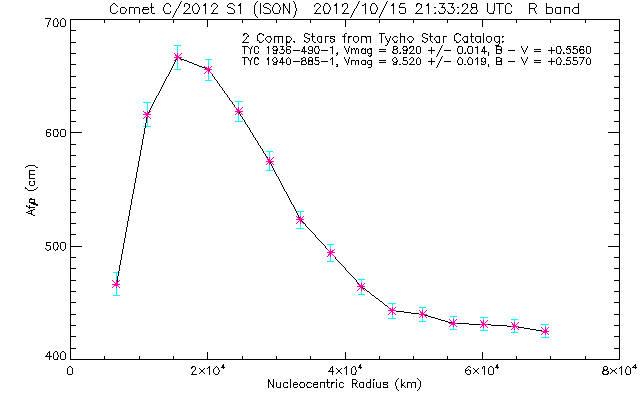
Copyright @ Man-To Hui 2012/10/19
|
|
| Mouse-over to browse the image with labeled versions attached. |
MPC observation computed with Astrometrica using both UCAC-3 and CMC-14 star catalogs -- the former for astrometric reduction and the latter for photometric work:
COD C42
OBS M.-T. Hui, X. Gao
MEA M.-T. Hui
TEL 0.36-m f/6.9 Schmidt-Cassegrain + CCD
NET UCAC-3
CK12S010 KC2012 12 17.72380 08 04 00.81 +30 00 20.6 16.2 N C42
CK12S010 KC2012 12 17.73638 08 04 00.28 +30 00 23.7 16.2 N C42
CK12S010 KC2012 12 17.74896 08 03 59.61 +30 00 25.4 16.1 N C42
CK12S010 KC2012 12 17.76155 08 03 59.01 +30 00 28.6 16.1 N C42
CK12S010 KC2012 12 17.77413 08 03 58.52 +30 00 30.7 16.1 N C42
Photometry result computed with FOCAS II, which processes images based upon the .LOG file of Astrometrica, by means of Multibox method:
Fisrt line:

I computed Afρ of the comet with a median stacked image of all the untrailed sequence. The two comparison stars were taken from Tycho Star Catalog. Peak Afρ is considerably larger than in previous observation. However, results between sub-sequences were not that consistent, probably owing to the changing focus of the setup attributed to the drastically varying temperature.
Copyright @ Man-To Hui 2012/12/25
|
|
| Mouse-over to browse the image without special-techniques applied versions attached. |
MPC observation computed with Astrometrica using both UCAC-3 and CMC-14 star catalogs -- the former for astrometric reduction and the latter for photometric work:
COD C42
OBS M.-T. Hui, X. Gao
MEA M.-T. Hui
TEL 0.36-m f/6.9 Schmidt-Cassegrain + CCD
NET UCAC-4
CK12S010 KC2013 02 02.65988 07 15 41.54 +31 44 53.6 15.7 N C42
CK12S010 KC2013 02 02.66567 07 15 41.13 +31 44 54.1 C42
CK12S010 KC2013 02 02.67343 07 15 40.64 +31 44 54.2 15.7 N C42
CK12S010 KC2013 02 02.67914 07 15 40.20 +31 44 54.5 15.8 N C42
CK12S010 KC2013 02 02.68500 07 15 39.89 +31 44 54.6 15.8 N C42
CK12S010 KC2013 02 02.69448 07 15 39.21 +31 44 54.9 C42
CK12S010 KC2013 02 02.69860 07 15 38.98 +31 44 55.0 15.6 N C42
CK12S010 KC2013 02 02.70515 07 15 38.52 +31 44 55.4 15.7 N C42
CK12S010 KC2013 02 02.71105 07 15 38.14 +31 44 55.5 15.7 N C42
CK12S010 KC2013 02 02.71679 07 15 37.77 +31 44 55.6 15.7 N C42
CK12S010 KC2013 02 02.72280 07 15 37.35 +31 44 55.8 C42
CK12S010 KC2013 02 02.72862 07 15 36.97 +31 44 56.0 15.7 N C42
CK12S010 KC2013 02 02.73441 07 15 36.60 +31 44 56.1 15.7 N C42
Photometry result computed with FOCAS II, which processes images based upon the .LOG file of Astrometrica, by means of Multibox method:
Fisrt line:

The magnitude fitting as a function of radius can be seen below. It confirms that the central condensation is very high, in consitent with "stellar appearance".

I computed Afρ of the comet with three median stacked images combined from the first thirty untrailed individuals. Two comparison stars were taken from Tycho Star Catalog -- TYC 2451-1828-1 and TYC 2452-0763-1. Peak Afρ is considerably larger than in previous observation. However, results between sub-sequences were inconsistent but decreased, probably owing to the changing ambient conditions, the most crucial of which might be the fact that the moon was to rise, however, high elevations of the atmosphere were already gradually influenced by the increasing intensity of the moonlight.
Copyright @ Man-To Hui 2013/02/21
|
|
| Poor tracking of the mount, thereby stars trailed in individuals. Focus not sharp either. Additionally the comet was situated amidst dense star field, so it was rather difficult to perform reliable measurements of cometary photometry and Afrho. |
MPC observation computed with Astrometrica using both UCAC-4 and CMC-14 star catalogs -- the former for astrometric reduction and the latter for photometric work:
Photometry result computed with FOCAS, which processes images based upon the .LOG file of Astrometrica, by means of Multibox method:
Interpretation for FOCAS table headings:
The upper section:
Fisrt line:COMET, UTC: refering to their original meanings respectively
DELTA: cometocentric distance of the Earth
Wafrho written by CARA Project was also applied for Af[rho] calculation. I could not understand the reason why the Af[rho] value of the comet apparently decreases dramatically compared to previous observations in a clear manner. I also employed a beta version of the Wafrho to repeat the computation with UCAC-4 instead, and the new result perfectly matched the one with TYC catalog. Photometry measurements of the comet by Wafrho appeared ~0.5 mag fainter than those derived by FocAs, indicating different DNs counting.
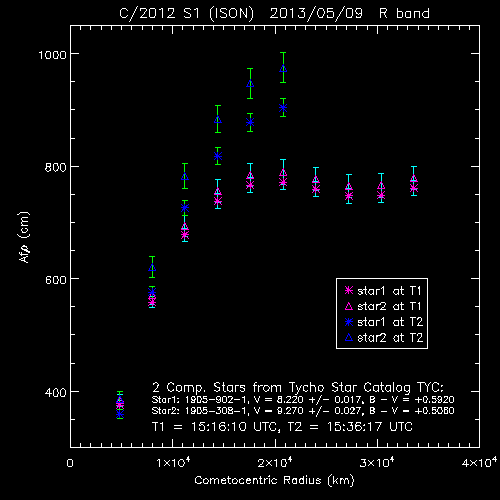 |
Follow-up will be performed weather permitting so as to check what the error is. The difference is not trivial at all, and all of these have been disappointing me for days.
Copyright @ Man-To Hui 2013/05/14
|
|
| During this observation the comet managed to avoid dense star field, and it was successfully captured near the center of the frames and thereby measurements of photometry and Afrho should be much more accurate than in last observation session. |
MPC observation computed with Astrometrica using both UCAC-4 and CMC-14 star catalogs -- the former for astrometric reduction and the latter for photometric work:
COD C42
OBS M.-T. Hui, X. Gao
MEA M.-T. Hui
TEL 0.36-m f/6.9 Schmidt-Cassegrain + CCD
NET UCAC-4
CK12S010 KC2013 05 15.62049 06 48 32.69 +28 53 40.5 15.8 N C42
CK12S010 KC2013 05 15.62465 06 48 32.82 +28 53 39.7 15.7 N C42
CK12S010 KC2013 05 15.62904 06 48 32.91 +28 53 39.1 15.7 N C42
CK12S010 KC2013 05 15.63346 06 48 33.08 +28 53 38.3 15.7 N C42
CK12S010 KC2013 05 15.63773 06 48 33.17 +28 53 37.9 15.7 N C42
CK12S010 KC2013 05 15.64201 06 48 33.34 +28 53 37.3 C42
CK12S010 KC2013 05 15.64589 06 48 33.43 +28 53 36.8 C42
Observations of the
last two lines suffered from deteriorating altitude, whereby the SNR of the comet became insufficient in terms of accurate photometry; only astrometry is preserved. The following is photometry result computed with FOCAS, which processes images based upon the .LOG file of Astrometrica, by means of Multibox method:Interpretation for FOCAS table headings:
The upper section:
Fisrt line:COMET, UTC: refering to their original meanings respectively
DELTA: cometocentric distance of the Earth
Wafrho written by the CARA Project was also applied for Af[rho] calculation. I could not understand the reason why the Af[rho] value of the comet apparently decreases dramatically compared to previous observations in a clear manner. I also employed a beta version of the Wafrho to repeat the computation with UCAC-4 instead, and the new result perfectly matched the one with TYC catalog. Photometry measurements of the comet by Wafrho appeared ~0.5 mag fainter than those derived by FocAs, indicating different DNs counting. The puzzle remains to be solved.
Copyright @ Man-To Hui 2013/05/26
Today I re-coadded the image sequence and re-measured the Afrho values of the comet in Wafrho. Totally 4 comparison stars with color indexes similar to the sun's in catalog UCAC-4 were used.
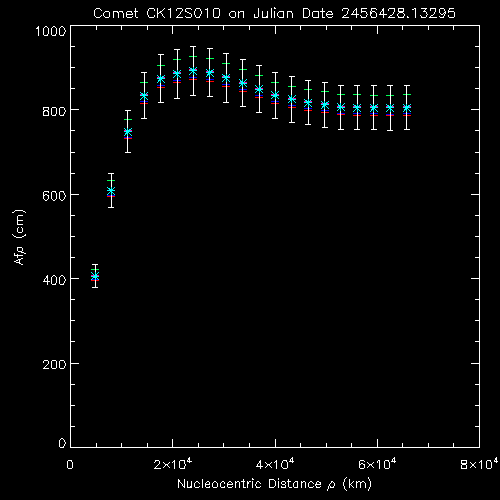 |
It thereby does prove that the declination of Af[rho] of the comet.
Copyright © Man-To Hui 2013/09/
02|
|
| Please note that the filter used was not standardized for photometry, and therefore this may well bring more uncertainty to the magnitude of the comet. The enlarged section is magnified 4x. |
Unfortunately since the imager Carl Chan was not familiar with imaging comets, he mistakenly regarded the mode as the one in DSO photographing, that the exposure of each of an individual image was as long as 10-min and consequently all but one was in good tracking and applicable for photometry.
As MaxImDL is proved accurate in terms of photometry, I applied the software for saving time. Overall 10 comparison stars adjacently surrounding the comet apparently close to the brightness of the comet by visual inspection were taken from the NOMAD catalog:
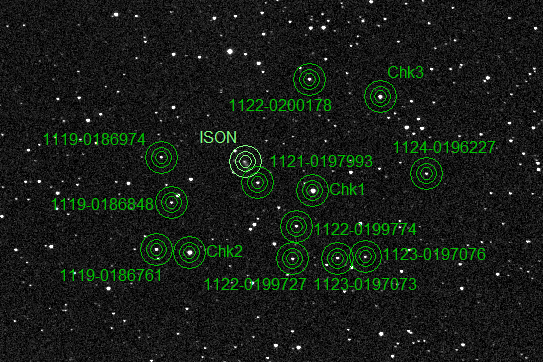
I assumed that the green filter shares the same transmission with the V band filter. The photometric aperture was set to 6-pixel in radius, sky annulus 10-pixel for the inner and 16-pixel for the outer. The final outcome rendered the magnitude enclosed by such an aperture as 13.538. Uncertainties from the zero point of the image (0.062) and noise of the image were both considered, as large as 0.105.
Copyright © Man-To Hui 2013/09/
02|
|
| Images taken in the course of SASP in C42. Unfortunately the quality of the calibration files was unsatisfactory, whereby the vignetting could not be completely removed. The resulting measurements of photometry were highly likely drowned in large uncertainties. To make matters worse, the pointing of the scope was so poor that the comet was situated very close to the edge. Whilst the scope with a larger aperture managed to reveal a longer tail of the comet, yet the coma it recorded was much smaller. |
MPC observation computed with Astrometrica using both UCAC-4 and CMC-14 star catalogs -- the former for astrometric reduction and the latter for photometric work:
COD C42
OBS M.-T. Hui, X. Gao
MEA M.-T. Hui
TEL 0.36-m f/6.9 Schmidt-Cassegrain + CCD
NET UCAC-4
CK12S010 KC2013 09 01.90199 08 43 13.11 +22 01 28.2 14.9 N C42
CK12S010 KC2013 09 01.90590 08 43 13.50 +22 01 24.9 14.9 N C42
CK12S010 KC2013 09 01.90978 08 43 13.84 +22 01 23.8 14.8 N C42
CK12S010 KC2013 09 01.91367 08 43 14.11 +22 01 22.9 14.8 N C42
CK12S010 KC2013 09 01.91770 08 43 14.52 +22 01 19.3 14.8 N C42
CK12S010 KC2013 09 01.92223 08 43 14.87 +22 01 18.6 14.7 N C42
The following is photometry result along with Afrho computed with FOCAS, which processes images based upon the .LOG file of Astrometrica, by means of Multibox method:
COD C42
OBS M.-T. Hui, X. Gao
CATALOG: USNO A2.0 / CMC-14 - BAND: R
10x10 20x20 30x30 40x40 50x50 60x60 SNR SB COD
COMET UTC +/- +/- +/- +/- +/- +/- N FWHM CAT
------------ ------------------- ----- ----- ----- ----- ----- ----- ---- ---- ---
C/2012 S1 01/09/2013 21:53:06 14.82 14.04 13.67 13.43 13.26 13.12 11.6 18.2 C42
C/2012 S1 01/09/2013 21:53:06* 0.07 0.07 0.07 0.07 0.06 0.06 6 4.3 CMC
AFRHO LOG
COMET UTC DELTA r BOX " MAG RSR CM +/- AFRHO OBS
------------ ------------------- ----- ----- ----- ----- --- ----- ---- ----- ---
C/2012 S1 01/09/2013 21:53:06 2.95 2.16 9.36 14.82 12 460 40 2.663 C42
FoCAs 3.43
www.astrosurf.com/cometas-obs
es.groups.yahoo.com/group/Cometas_Obs
Interpretation for FOCAS table headings:
The upper section:
Fisrt line:COMET, UTC: refering to their original meanings respectively
DELTA: cometocentric distance of the Earth
I stacked the image sequence and measured the Afrho values in Wafrho. Totally 3 comparison stars with color indexes similar to the sun's in catalog UCAC-4 were used.
 |
The Af[rho] amount significantly dropped, compared to the observation made in Feb this year.
I applied APER.pro for measuring the brightness of the comet on the image with registration on the cometary motion. 9 comparison stars around the comet were taken from the same image sequence yet stacked with alignment to stars to obtain the zero point value. Fianlly a series of apertures were centered on the optocenter which was solved by CNTRD.pro and yielded the multiaperture photometry. Unfortunately, the largest aperture could merely have a radius of 20-arcsec because a bright star was closely situated.
It is frustrating to witness greater discrepancies between the data by APER.pro and those given by FOCAS as the photometric apertures went larger, albeit the latter was employing square boxes. With these limited data I obtained the magnitude enclosed by an infinite circular aperture $m_\infty = 14.070 \pm 0.053$. The uncertainty is a combination of the error in data fitting and the errors of the magnitude data themselves. However, it is very likely that the total brightness could have been brighter because the brightening trend in the inner coma might not render a correct extrapolation to the outer coma. I also noticed that the coma captured by the setup appeared considerably smaller than the setup with a smaller aperture and a shorter focal length. Therefore the authentic total brightness of the coma should in fact be brighter than what I obtained with these SASP images.
The following graphic illustrates the radial profile of the comet. The image was transformed to polar coordinates, then the azimuthal profile was medianed and finally the resulting data were plotted. $\rho$ is in arcsec whilst the intensity is in ADU.
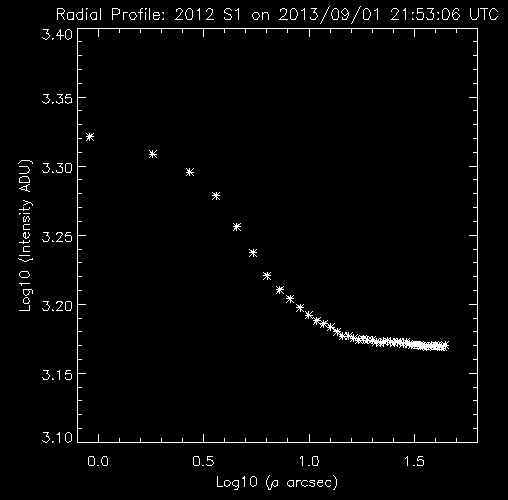 |
Copyright © Man-To Hui 2013/09/
04|
|
| Images taken in the course of CSP in C42. As the signal is transmitted through a V band filter, the photometric quality of thise session was excessively satisfactory. |
MPC observation computed with Astrometrica using NOMAD star catalog for astrometry:
COD C42
CON M.-T. Hui, Wuhan University, China
OBS X.Gao, M.-T. Hui
MEA M.-T. Hui
TEL 0.11-m f/5.0 refractor + CCD
NET NOMAD
CK12S010 KC2013 09 11.88831 08 59 00.79 +20 47 20.6 13.9 N C42
CK12S010 KC2013 09 11.90396 08 59 02.10 +20 47 13.9 13.6 N C42
CK12S010 KC2013 09 11.92014 08 59 04.31 +20 47 02.6 13.3 N C42
I stacked the image sequence and measured the Afrho values in Wafrho. Totally 8 comparison stars with color indexes similar to the sun's in catalog UCAC-4 were used.
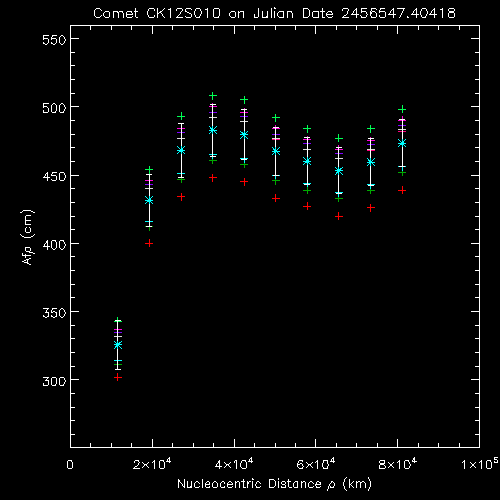 |
I applied APER.pro for measuring the brightness of the comet on the image with registration on the cometary motion. 16 comparison stars around the comet were taken from the same image sequence yet stacked with alignment to stars to obtain the zero point value. Fianlly a series of apertures were centered on the optocenter which was solved by CNTRD.pro and yielded the multiaperture photometry.
ZP = 22.0397+-0.0389938
aper mag emag
1. 16.310+-0.095
2. 14.955+-0.061
3. 14.288+-0.053
4. 13.907+-0.050
5. 13.666+-0.048
6. 13.491+-0.048
7. 13.366+-0.048
8. 13.264+-0.048
9. 13.177+-0.048
10. 13.097+-0.048
11. 13.008+-0.048
12. 12.922+-0.047
13. 12.835+-0.047
14. 12.764+-0.047
15. 12.710+-0.047
16. 12.664+-0.048
17. 12.633+-0.048
18. 12.602+-0.048
19. 12.563+-0.048
20. 12.525+-0.049
21. 12.487+-0.049
22. 12.455+-0.049
23. 12.428+-0.050
24. 12.391+-0.050
The unit of the apertures are in pixel.
With photometric data I obtained the magnitude as if enclosed by an infinite circular aperture $V_\infty = 12.358 \pm 0.011$. The uncertainty was calculated according to the propagation of the errors of the magnitude data themselves. R.M.S. of the fit is around 0.10.
In order to be in consistency with the photometric data, I calculated Afrho myself in IDL. The following shows the plot.
 |
The trend is similar to the dataset measured in Wafrho, and the peak of the Afrhos indeed is placed around $\rho$ ~ 3E+04 km, however, the slope is slightly different, although Wafrho uses square boxes. I had checked the steps in my scripts so do not think that there was any typo or severe error. More tests to be done.
Copyright © Man-To Hui 2013/09/15
|
|
| Images taken in the course of CSP in C42. The sunward jet should be genuine as it is repeatedly shown in every of the specialized processed images above, thereby ruling out any possibility of it being an artifact. |
MPC observation computed with Astrometrica using NOMAD star catalog for astrometry:
COD C42
OBS X.Gao, M.-T. Hui
MEA M.-T. Hui
TEL 0.11-m f/5.0 refractor + CCD
NET NOMAD
CK12S010 KC2013 09 26.88184 09 26 06.99 +18 25 32.6 13.6 N C42
CK12S010 KC2013 09 26.89868 09 26 08.71 +18 25 24.9 13.6 N C42
CK12S010 KC2013 09 26.91349 09 26 10.55 +18 25 14.6 13.4 N C42
CK12S010 KC2013 09 26.92759 09 26 12.21 +18 25 05.5 13.2 N C42
CK12S010 KC2013 09 26.94210 09 26 13.92 +18 24 55.8 13.3 N C42
Unfortunately the report was rejected by the MPC in the automatic reply. Photometry and astrometry are hard to be compatible! I stacked the image sequence by means of median combining respectively with alignment to the comet and to the field stars, and the Afrho values in Wafrho were measured. Totally 6 comparison stars with color indexes similar to the sun's in catalog UCAC-4, adjacent to the comet were used.
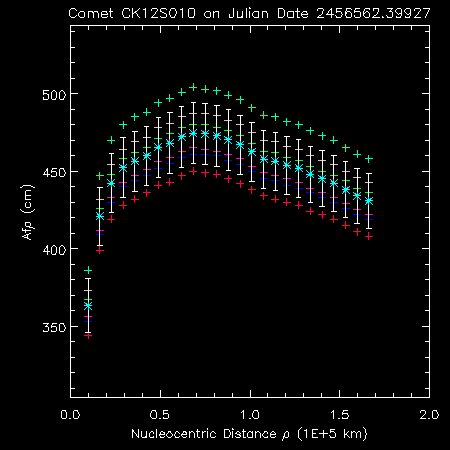 |
I applied APER.pro for measuring the brightness of the comet. 11 comparison sun-analog stars in APASS around the comet were taken from the same image sequence yet stacked with alignment to stars to obtain the zero point value. Fianlly a series of apertures were centered on the optocenter which was solved by CNTRD.pro and yielded the multiaperture photometry.
ZP = 22.5530+-0.0582017
aper mag emag
2. 14.390+-0.064
4. 13.474+-0.061
6. 13.032+-0.060
8. 12.736+-0.060
10. 12.503+-0.060
12. 12.314+-0.059
14. 12.177+-0.059
16. 12.058+-0.059
18. 11.957+-0.059
20. 11.867+-0.059
22. 11.789+-0.059
24. 11.733+-0.059
26. 11.683+-0.059
28. 11.640+-0.059
30. 11.598+-0.060
32. 11.566+-0.060
34. 11.535+-0.060
36. 11.509+-0.060
38. 11.489+-0.060
40. 11.475+-0.060
The unit of the apertures are in pixel.
With photometric data I obtained the magnitude as if enclosed by an infinite circular aperture $V_\infty = 11.336 \pm 0.013$. The uncertainty was calculated according to the propagation of the errors of the magnitude data themselves. R.M.S. of the fit is 0.012.
In order to be in consistency with the photometric data, I employed my IDL routine written by myself for calculating Afrho:
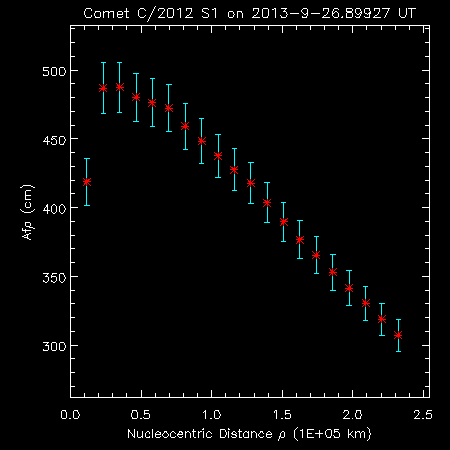 |
I noticed that the declining trend at large $\rho$ is steeper than that shown by the plot with Wafrho's results. Through tests it was found that the differences all come from the determination of the background value which was used to be subtracted from the mixed flux enclosed by the aperture centered on the comet's optocenter. Wafrho gives a fainter background, i.e. smaller ADU, whereas APER.pro renders a brighter one. So as to eliminate different factors involved since APER.pro uses a circular aperture whilst Wafrho exploits a square box, I selected several regions without much star contamination in square boxes and computed the values of the background. All of them were close to the result given by APER.pro, ADU larger than Wafrho's. I tend to rely on APER.pro, of which the fame has already been well established throughout the community.
 |
Copyright © Man-To Hui 2013/09/30
|
|
I applied APER.pro for measuring the brightness of the comet. 6 comparison sun-analog stars in APASS around the comet were taken from the same image sequence yet stacked with alignment to stars to obtain the zero point value. Fianlly a series of apertures were centered on the optocenter which was solved by CNTRD.pro and yielded the multiaperture photometry.
ZP = 21.1502+-0.0466107
4.5 13.057+-0.074
7.0 12.565+-0.071
9.5 12.257+-0.071
12.0 12.005+-0.070
14.5 11.777+-0.069
17.0 11.643+-0.070
19.5 11.593+-0.074
22.0 11.585+-0.080
24.5 11.539+-0.084
27.0 11.508+-0.089
29.5 11.502+-0.096
32.0 11.478+-0.101
The unit of the apertures are in pixel.
With photometric data I obtained the magnitude as if enclosed by an infinite circular aperture $V_\infty = 11.431 \pm 0.023$.
Copyright © Man-To Hui 2013/11/12
|
|
| Pixel size: 4.97"/pixel, rotation: -66.36 deg. 16' tail in length in P.A. 296 deg, coma size 2'.4 in diameter. |
I applied APER.pro for measuring the brightness of the comet. 10 comparison sun-analog stars in APASS around the comet were taken from the same image sequence yet stacked with alignment to stars to obtain the zero point value. Fianlly a series of apertures were centered on the optocenter which was solved by CNTRD.pro and yielded the multiaperture photometry.
ZP = 22.1886+-0.0328708
aper mag emag
2.0 14.130+-0.055
4.0 13.034+-0.044
6.0 12.515+-0.041
8.0 12.181+-0.040
10.0 11.951+-0.040
12.0 11.776+-0.040
14.0 11.630+-0.040
16.0 11.486+-0.040
18.0 11.347+-0.040
20.0 11.252+-0.040
22.0 11.176+-0.040
24.0 11.121+-0.041
26.0 11.065+-0.041
28.0 11.026+-0.042
30.0 10.986+-0.043
32.0 10.953+-0.043
34.0 10.940+-0.045
36.0 10.952+-0.046
38.0 10.977+-0.049
40.0 11.015+-0.051
42.0 11.059+-0.055
44.0 11.089+-0.058
46.0 11.108+-0.061
48.0 11.157+-0.066
The unit of the apertures are in pixel.
I also solved the Afrho profile for the comet:
 |
Copyright © Man-To Hui 2013/11/12
|
|
MPC observations with comparison star catalog NOMAD:
COD C42
OBS X.Gao, M.-T. Hui
MEA M.-T. Hui
TEL 0.11-m f/5.0 refractor + CCD
NET NOMAD
CK12S010 KC2013 10 08.93312 09 52 42.43 +15 48 13.3 13.1 N C42
CK12S010 KC2013 10 08.94330 09 52 44.03 +15 48 02.9 13.3 N C42
CK12S010 KC2013 10 08.95295 09 52 45.35 +15 47 54.8 13.2 N C42
I applied APER.pro for measuring the brightness of the comet. 15 comparison sun-analog stars in APASS around the comet were taken from the same image sequence yet stacked with alignment to stars to obtain the zero point value. Fianlly a series of apertures were centered on the optocenter which was solved by CNTRD.pro and yielded the multiaperture photometry.
ZP = 23.0333+-0.0285470
aper mag emag
5.0 12.968+-0.031
10.0 12.154+-0.030
15.0 11.693+-0.029
20.0 11.390+-0.029
25.0 11.172+-0.029
30.0 11.011+-0.029
35.0 10.899+-0.029
40.0 10.815+-0.029
45.0 10.744+-0.029
50.0 10.689+-0.029
55.0 10.639+-0.029
60.0 10.595+-0.029
65.0 10.569+-0.029
70.0 10.562+-0.030
75.0 10.562+-0.030
80.0 10.566+-0.030
85.0 10.574+-0.030
90.0 10.581+-0.031
95.0 10.598+-0.031
100.0 10.618+-0.032
The unit of the apertures are in pixel.
I also solved the Afrho profile for the comet:
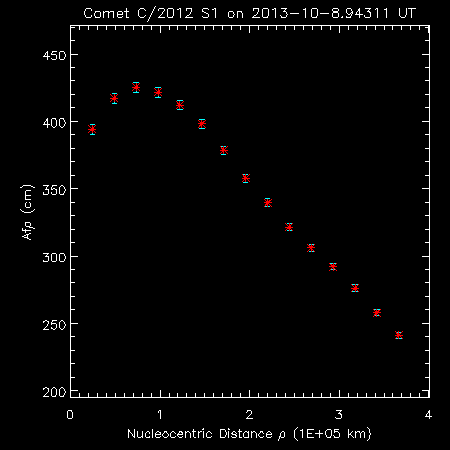 |
Copyright © Man-To Hui 2013/11/12
|
|
MPC observations with comparison star catalog UCAC-4:
COD C42
OBS X.Gao, M.-T. Hui
MEA M.-T. Hui
TEL 0.36-m f/6.9 Schmidt-Cassegrain + CCD
NET UCAC-4
CK12S010 KC2013 10 26.95147 10 49 25.13 +09 16 56.6 13.8 N C42
CK12S010 KC2013 10 26.95452 10 49 25.91 +09 16 51.2 13.8 N C42
CK12S010 KC2013 10 26.95622 10 49 26.32 +09 16 47.7 13.8 N C42
CK12S010 KC2013 10 26.95800 10 49 26.78 +09 16 44.2 13.8 N C42
I did not measure photometry of this comet in a serious manner because the CCD is unfiltered. The comet is now close to the sun and thereby strong activity with the gas.
Copyright © Man-To Hui 2013/12/01
|
|
MPC observations with comparison star catalog UCAC-4:
COD C42
OBS X.Gao, M.-T. Hui
MEA M.-T. Hui
TEL 0.36-m f/6.9 Schmidt-Cassegrain + CCD
NET UCAC-4
CK12S010 KC2013 11 01.95919 11 17 20.23 +05 43 05.0 13.4 N C42
CK12S010 KC2013 11 01.96075 11 17 20.73 +05 43 01.1 13.4 N C42
CK12S010 KC2013 11 01.96231 11 17 21.25 +05 42 57.1 13.4 N C42
CK12S010 KC2013 11 01.96413 11 17 21.77 +05 42 52.7 13.3 N C42
CK12S010 KC2013 11 01.96568 11 17 22.33 +05 42 48.9 13.4 N C42
CK12S010 KC2013 11 01.96725 11 17 22.78 +05 42 45.0 13.4 N C42
CK12S010 KC2013 11 01.96885 11 17 23.31 +05 42 41.0 13.4 N C42
CK12S010 KC2013 11 01.97042 11 17 23.81 +05 42 36.8 13.4 N C42
I did not measure photometry of this comet in a serious manner because the CCD is unfiltered. The comet is now close to the sun and thereby strong activity with the gas.
Copyright © Man-To Hui 2013/12/01
|
|
MPC observations with comparison star catalog UCAC-4:
I did not measure photometry of this comet in a serious manner because the CCD is unfiltered. The comet is now close to the sun and thereby strong activity with the gas.
Copyright © Man-To Hui 2013/12/01
|
|
MPC observations with comparison star catalog NOMAD
COD C42
OBS X.Gao, M.-T. Hui
MEA M.-T. Hui
TEL 0.36-m f/6.9 Schmidt-Cassegrain + CCD
NET NOMAD
CK12S010 KC2013 11 12.96704 12 33 16.81 -04 21 33.1 10.9 N C42
CK12S010 KC2013 11 12.96956 12 33 18.18 -04 21 43.8 10.9 N C42
CK12S010 C2013 11 12.97084 12 33 18.99 -04 21 50.0 11.0 N C42
CK12S010 KC2013 11 12.97220 12 33 19.60 -04 21 54.7 11.0 N C42
CK12S010 KC2013 11 12.97460 12 33 20.87 -04 22 05.4 11.0 N C42
CK12S010 KC2013 11 12.97789 12 33 22.25 -04 22 16.0 11.1 N C42
I did not measure photometry of this comet in a serious manner because the CCD is unfiltered. The comet is now close to the sun and thereby strong activity with the gas.
Copyright © Man-To Hui 2013/12/01
|
|
Astrometrica failed to solve plate constants for the images, and therefore I simply rejected astrometric measurement.
Copyright © Man-To Hui 2013/12/01
|
|
Again Astrometrica failed to solve plate constants for the image sequence. The appearance of the coma near the optocenter changes dramatically morphologically after an outburst on Nov 13.
Copyright © Man-To Hui 2013/12/01
|
|
No astrometric measurement. Unfortunately this is the last observation of this comet remotely imaged at C42.
Copyright © Man-To Hui 2013/12/01
Feel free to e-mail me with any doubts or questions.